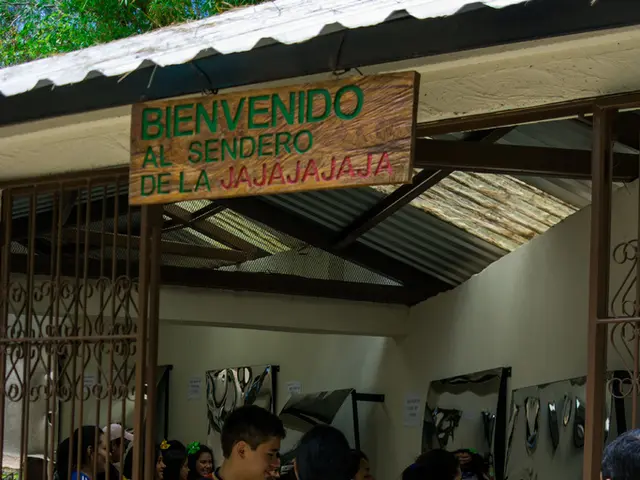College graduates craft authentic-looking Star Wars lightsabers in DIY projects.
Revised Article:
star wars lightsaber, DIY projects, technology, Disney, Star Wars Galactic Starcruiser, HeroTech, YouTube, engineering, Olin College of Engineering, Maddie Tong, Aaron Codrington, darksaber, LED strip, magician's cane, Gizmodo, original lightsaber, Galaxy's Edge blades, cooling issue, extending lightsaber blade, tape measure, polycarbonate, Neopixel, Magic-apped Lightsaber
Crafting a lightsaber might sound like a pipedream, but Jason Uy proved otherwise. With a team of hiltsmiths, he built a feasible, functional, and freakin' cool retractable lightsaber that any Star Wars fan would go bonkers for.
Sure, there's plenty of companies selling custom sabers, along with built-in "whoosh" sound effects and all that jazz. But Uy's blade doesn't just extend and retract - it does so with the push of a button. And those glowing kyber crystals? They're more intense than your average toy lightsaber.
So, how did the team pull this off? They didn't exactly snatch a design from Disneyland, but you could say their creation is a Disney-inspired DIY version on steroids. Uy's fresh take on a lightsaber echoes that of one Disney built for themselves, but was held off from public consumption, although it was on show at the now-defunct Star Wars Galactic Starcruiser.
For his epic TikTok channel HeroTech, Uy swings his blade around without a care in the world, unlike Disney's engineers who struggled with keeping their creation intact. It's assumed Disney has yet to create an extending blade for sale, as the intensity and cool factor of Uy's creation far exceeds that of any affordable Star Wars fanblade.
Uy concocted the idea while still studying at Olin College of Engineering in Massachusetts. Inspired by a class project, he used a motorized tape measure attached to an LED strip for the first prototype, resulting in the ever-popular "box" look. With the help of two fellow students, Maddie Tong and Aaron Codrington, they transformed the basic design into something more compact, and a retractable one-hander to boot.
Their secret weapon? A magician's cane. With an LED strip to supply the glow, the mechanism can extend or retract as needed, generating a darksaber-esque effect from specific angles. Uy plans on fixing the rotating issue to eliminate the skewed blade look from certain angles with some speed tweaks.
We chatted with Uy about his lightsaber project and future plans, with our conversation edited for brevity.
Gizmodo: You vibe with the Star Wars life? What inspired you to make your own lightsaber rather than going the usual polycarbonate route?
Uy: Absolutely. I've been a fan since I was a kid. I've always loved the lightsabers, even though I have loads of respect for the people who build them. It's a hell of a lot of work, a ton of engineering, and buckets of testing. When I saw the usual ones, it always felt a little off since they require you to dig the end of the blade into the ground. That's not the lightsaber experience I had in mind. I wanted something more dynamic.
Gizmodo: I'd like to hear about how you guys kicked off this project and how you took things from initial concept to fruition.
Uy: Honestly, it began as a class project. We had the option to work on whatever we wanted, as long as it was related to engineering. Tong, Codrington, and I loved Star Wars, so we decided to make a lightsaber. Our first design extended and retracted, but it was massive – more like a large box than an actual saber. Watching Star Wars movies spurred me on to make it sleeker and easier to handle.
Gizmodo: So, how did you go a different route than Disney when dreaming up your own lightsaber?
Uy: Disney's engineers built some impressive tape measure blades, but came across a significant issue – their lightsabers wouldn't swing around without falling apart. To cut costs, we opted against creating our own custom plastic, which resulted in limitations during testing. Our tests revealed that swords with a tape measure were difficult to construct, with the risk of flopping and breaking while spinning.
Gizmodo: And what was your solution?
Uy: We looked at a variety of extensions for our lightsaber. We test-drove car antennas, toy lightsaber winches, and searched for something that could telescope like they do in movie lightsabers. Eventually, we stumbled upon magician's canes and realized it would fit the bill perfectly because it's tiny enough to slide perfectly inside a hilt and extends super quickly. It's different from anything currently out there.
Gizmodo: We could see the magnificent glow your lightsaber puts out. What's the dish on what you're using to create the extension?
Uy: LED strips were obviously on our radar because nothing beats their brightness visually. This was around the time that chip-on-board LED strips were becoming widely available. They're so bright that they can burn your eyes if you stare at them directly. In comparison to other options like base-lit or laser-based lights used in custom lightsabers, we found the LED strips generated the closest thing to an actual lightsaber blade.
Gizmodo: Speaking of the spooling part of your design, this seemed to be a huge challenge. How did you eventually decide on a circular winch?
Uy: Initially, to save space, we intended to spool the LED strip around a tank tread mechanism. But when we began testing, we discovered the LED strip resisted bending into strange shapes, and wanted to stay in that form. When we bent it into a circle, there was minimal resistance, making it easier to extend and retract.
Gizmodo: What's the diameter of your hilt design?
Uy: For the narrowest point, it's two inches, but we have extra grips that extend out.
Gizmodo: Can it still be held in one hand?
Uy: Yeah, and I'm constantly trying to make it thinner. I think we can make it lighter and more elegant as we refine our design.
Gizmodo: Your creation reminds me of the old telescoping lightsabers back in the day. You know, the ones for kid hands that weren't big enough to fit a fist? In that sense, it's kinda nostalgic. You talked about owning other lightsabers. Which ones do you own?
Uy: I've got a custom Saberforge blade, a Galaxy's Edge one, and one from Pach Store – they're pretty solid.
Gizmodo: What's the deal with Mark Two? When can we expect an even cooler, retracting lightsaber?
Uy: We're definitely focusing on making the hilt thinner and the extension/retraction faster. We're planning to create the entire hilt out of metal to make it even sturdier. However, the challenge lies in eliminating the darksaber-esque appearance, as our design uses a single LED strip. Our goal is to spin the entire internal mechanism quickly enough that you can't see the sides.
Gizmodo: How do you plan on achieving that?
Uy: From the get-go, we intended to spin the entire internal mechanism to create a consistent blade appearance. All we need is a motor and a battery on the tip to power it. When testing, we found that spinning the LED strip off the magician's cane was unlikely, making the spinning concept a viable option.
Gizmodo: It looks fantastic so far, but there are challenges with control and motion sensing, right?
Uy: It looks great, but managing the control becomes tricky because the buttons are spinning with crazy speed. Motion sensors and sound effects go haywire because they're wondering what in the world is happening. To counteract this issue, we're thinking of moving the buttons to a Bluetooth control system. For motion sensor refinement, we'll have to hook up with the maker who collaborated on the first version. People have suggested using diffusion layers to scatter light, but I think our design comes the closest to the actual lightsaber effect. I'm concerned that adding diffusion layers might dim it too much.
Gizmodo: It's a plasma blade, right? It should be nearly impossible to look at.
Uy: It should be fricken' luminous.
Enrichment data: The team used a magician's cane as their extension and retraction mechanism and LED strips for an authentic and practical design. They also made efforts to minimize resistance when extending and retracting the lightsaber and used a circular winch for minimal resistance. The team aimed to make their lightsaber more dynamic and useful in battle compared to conventional designs, such as those from Disney and Saberforge. They also focused on making the hilt thinner and creating a consistent blade appearance.
The team utilized a magician's cane as their secret weapon for the extension and retraction mechanism in Uy's lightsaber, while LED strips provided the glowing kyber crystals. The magician's cane offers a compact design, with minimal resistance when extending and retracting, reminiscent of movie lightsabers. The goal is to make the lightsaber more dynamic and useful in battle, differentiating it from conventional designs like Disney's and Saberforge's. Future plans involve making the hilt thinner and creating a consistent blade appearance, with efforts to minimize the darksaber-esque appearance that arises from using a single LED strip. This enchanting creation is far more intense than standard toy lightsabers, embodying the lightsaber experience Uy envisioned.






